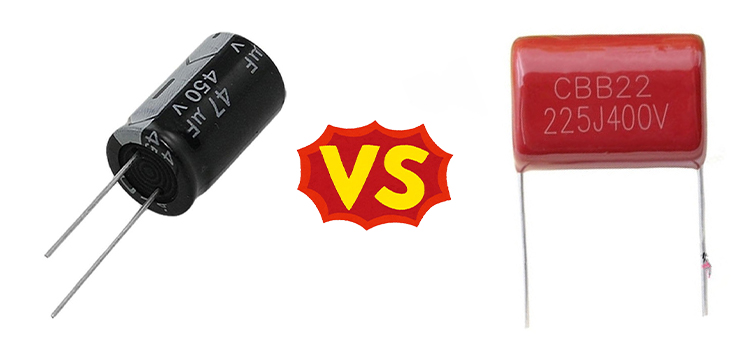Polarized vs Non-Polarized Capacitor | Do They Have the Same Fundamentals?
Both polarized and non-polarized capacitors have the same fundamentals: they release and storage charges. Varied medium, performance, capacity, and structure lead to the difference between these two types of capacitors.
In a circuit, a non-polarized (“non-polar”) capacitor has no implied polarity and can be utilized in any direction. But the intrinsic polarity of a polarized (“polar”) capacitor means it may only be connected in one direction in a circuit. This is the primary difference between them.

What are the Differences Between Polarized and Non-Polarized Capacitors?
A polarized capacitor can only be used in one direction in a circuit. A plus (+) and a negative (-) sign are placed next to each other.
The plus sign is connected to the circuit’s most positive part, whereas the minus sign is connected to the circuit’s most negative element. Polarized capacitors are commonly used in power supplies to filter out ripple voltage following rectifier diodes.

A non-polarized capacitor can be wired in any direction. They’re mostly utilized for signal coupling to isolate an AC voltage riding on a wire.
Constructional Difference of Polarized and Non-polarized Capacitor
The primary reason is due to physical limitations. Voltage and capacity are the two most critical elements that influence capacitor size. A bigger capacity equates to a larger size.
Ceramic capacitors are the most often used non-polarized capacitors. High-capacity ceramic capacitors are not produced by manufacturers. Because their size will expand as well.
In addition, the capacitor will be more unreliable. A polarized capacitor has a higher capacity in a smaller package. The electrolytic form of a polarized capacitor is the most common.
So the main distinction is a modification in the production process to increase capacity. A polarized capacitor is the result of this. Higher capacity necessitates the use of polarized capacitors.
Can You Use a Non-polarized Capacitor Instead of Polarized?
Yes, a non-polarized capacitor can be used instead of a polarized one. Non-polarized capacitors are polarized capacitors’ supersets. When replacing an electrolytic with a ceramic, polarization is not an issue.
In general, a polarized capacitor can be replaced by a non-polarized capacitor with the same capacitance and a voltage rating equal to or higher than the original. Unless you know the circuit will only ever apply voltage in one polarity, non-polarized capacitors should only be replaced with other non-polarized capacitors.
In low-frequency applications, a polarized capacitor would be preferable over a non-polarized capacitor.
What is the Advantages of a Non-polarized Capacitor?
Non-polarized capacitors are utilized in pure alternating current circuits and can also be employed in high-frequency filtering because of their low capacitance. They’re mainly used in coupling, decoupling, feedback, compensation, and oscillator circuits.
They have less leakage current than polarized ones, but they also have less capacitance per size. The key advantage is that they keep their capacitance even when they are biased in both directions.
So, they are beneficial in situations where the voltage will never change polarity on them when used properly.
Do I need a Polarized Capacitor?
Polarized capacitors are used in filtering power supplies (storage). They’re also used to prevent DC in the amplifier stages when they’re coupled together. They provide massive capacitance values in a small, cost-effective package.
People also use polarized caps because they often cost much less than non-polarized caps of the same capacitance and voltage rating.
What is the Difference between a Non-polarized Capacitor and an Electrolytic Capacitor?
An electrolytic capacitor is a polarized capacitor with an anode or positive plate consisting of a metal that has been anodized to generate an insulating oxide layer. Whereas capacitors with neither positive nor negative polarity are known as non-polarized capacitors.
The electrolytic capacitor aids in the coupling, decoupling, power supply filtering, and other tasks that are typically greater than 1 MF. Non-polarized capacitors are utilized in a variety of applications, including resonance, coupling, frequency selection, current limiting, and more.
Is a non-polarized Capacitor Always Better than a Polarized One?
It is dependent on the application for which it is utilized. A polarized capacitor has polarity and is employed in DC (direct current) circuits for smoothing a ripple on a full wave bridge rectifier’s output, timing, and waveform slope modification, among other things.
Non-polarized NP types can also be used for timing, but they allow AC, or alternating current, which means oscillating electrical signals that cycle through both polarities.
As a result, non-polarized components are commonly utilized in signal conditioning, frequency-dependent filters, DC bias elimination, and other applications.
Conclusion
Polarized Capacitors are the ones that have specific positive and negative polarities. The non-polarized capacitor is a type of capacitor that is not polarized which means this capacitor has neither positive polarity nor negative polarity.
So, differences between them occur in performance, capacity, structure, and in various environments.
Subscribe to our newsletter
& plug into
the world of circuits